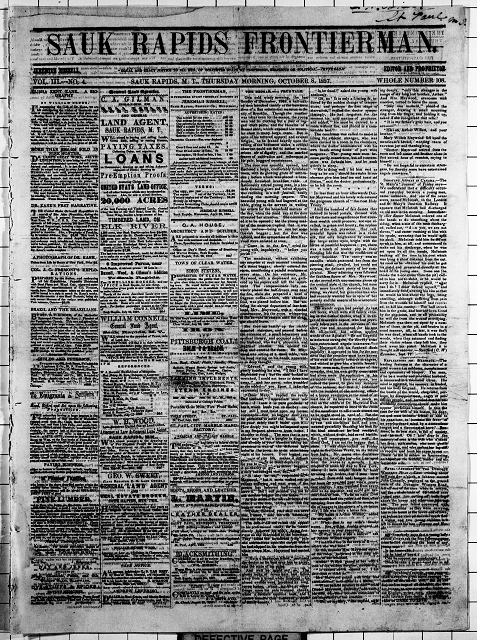Sauk Rapids Frontierman
Sauk Rapids frontierman (Sauk Rapids, Minn.) 1855-1860 Browse the title
The Sauk Rapids Frontierman was aptly named. When Jeremiah Russell published the first issue of his 6-column, 4-page weekly in the infant village at the Mississippi River rapids near the mouth of the Sauk in early May, 1855, it was Minnesota Territory’s first newspaper above the Falls of St. Anthony. It was printed on a heavy cast-iron hand press laboriously hauled 78 miles upriver from St. Paul, where it had produced the territory’s first newspaper in 1849.
Like so many frontier newspapers, its publication was intended to encourage settlement and profitable land speculation. Russell, Register of the U.S. Land Office in Sauk Rapids, owned a stake in both the Sauk Rapids townsite and the water power at the rapids, while his first editor, attorney William H. Wood, was Land Office Receiver. George W. Benedict, the Canadian-reared printer whom they lured from his Tecumseh, Michigan, newspaper, subsequently shared both Russell’s editing duties and his speculative bent. The editors’ varied interests, “hard times,” and small local numbers--Sauk Rapids township had a population of only 234 by late 1857--periodically interrupted publication for months at a time.
But the Frontierman’s real significance lay in the broader Upper Country readership for whom it catered and whose doings it reported. Russell had arrived in the Lake Superior country from New York State in 1835 at the age of 26, and after a varied frontier career, went into Indian trading for Charles H. Oakes of the American Fur Co., married Oakes’s mixed-race daughter, and in 1849 opened his own trading post near Sauk Rapids. The village developed as an outfitting center and retirement refuge for northern Minnesota’s diverse population of traders, trappers, and lumbermen, and the Frontierman’s columns reflected their changing lives and ambitions, and those of their Native American neighbors.
Pro-railroad editorials, reports from “agricultural editor” Oliver H. Kelley (later founder of the Grange agricultural fraternal organization), “sketches of our country” chronicling local settlements, and church picnic and concert notices jostled with ads for upcountry and downriver trading posts, accounts of Dakota war parties and Ojibwe mission schools, and vivid depictions of voyageurs’ winter camps and Red River ox cart trains. Politically the paper was fiercely Democratic, reflecting Minnesota fur trade politics more generally, and gave ample play to Sylvanus Lowry’s side in his notorious 1858 feud with Jane Grey Swisshelm, editor of the nearby St. Cloud Visiter. Lowry, with Sauk Rapids connections as the new husband of William Wood’s sister, was also a fellow fur trader and Democrat.
By January 1860, however, with a divisive presidential election in the offing, Jeremiah Russell was ready to abandon “the embarrassments consequent upon sustaining a paper in such a country as this,” and conveyed his newspaper’s plant to Wood and his wife, whose new title, the New Era, would “rise, Phoenix like, from the ashes of the Frontierman.” George Benedict remained as its printer, and went on to a Minnesota journalistic career that included the 1868 founding and long-time ownership of the Sauk Rapids Sentinel.
